Why an Overclockable Core i3 Might Not Exist: The Supermicro C7H170-M and Intel Core i3-6100TE Review
by Ian Cutress on March 17, 2016 10:30 AM EST- Posted in
- CPUs
- Intel
- Motherboards
- Core i3
- Supermicro
- Overclocking
Supermicro C7H170-M Software
Historically outside of the big four motherboard manufacturers mentioning a software package usually throws up some horror stories or completely blank looks. I have had manufacturers provide just the basic drivers on disk before, or that plus a basic tool with a poor GUI that ends up crashing when you select a few options. I set aside my predispositions, as with every review, and was looking forward to Supermicro’s software attempts, especially given our previous discussions about how interested they are in the consumer market. In our meetings together back at Computex I laid out the fact that their competitors have many years of experience in this, so it may take some time to match their quality. In a surprising twist, it seems that Supermicro has fallen onto their historic experience and gone not so much with a software GUI, but a web interface for their analysis tools. They call it Super Doctor 5.
I should explain. Supermicro, as a server company, has for many years dealt with management chips (such as Aspeed variants) that allow users to access some system controls and monitoring tools via a web interface even when the system is powered but not turned on. Having created their own IMPI interfaces for these management chips for a number of years, these tools were turned to the consumer crowd. Typically a consumer motherboard will not have a management chip, so this is more just an interface for the user to see the current status or adjust some minor aspects to the system.
As shown in the graph above, after an initial install, we get the standard motherboard monitoring metrics: fan speed, voltages and temperatures. There is the motherboard name listed, but we don’t have a series of the usual information I would want: CPU installed, CPU frequency, memory installed, memory speed, storage devices attached, boot order, fan speeds, and/or perhaps even a picture of the motherboard in use. There are a lot of things possible, but this is a basic list I would expect.
Perhaps unsurprisingly then, all the information I want is in the System Info tab along the top. The interface is easy to use, for sure: a summary with separate options on the left, with the results on the right. The problem for me is that the interface is lifeless – there’s no user experience here. A user in 2016 normally requests a tailored and styled experience, but here there is none to speak of.
Some of the sub menus, like this Disk Drive one, is more along the lines of what looks good, although the decision for width being at 100% makes everything look stretched.
The configuration tab links in with the hardware monitoring to give a series of alerts should the system get too hot or something fail and voltages drop. A user can set up an SMTP email server which can be used to send an email when it happens – a standard thing in the server industry, but you rarely see it in the consumer part because if the system gets a low voltage point, it is more likely to shut off rather than have something always-on to send an email. There is also an option here for users to flash the BIOS.
The monitoring tab shows the boundaries for each of the components the user can monitor, and makes them adjustable via text boxes.
One interesting addition is this tab on power control, to turn the system off. Again, this is more of a server feature – log in through the management chip in order to restart a system that isn’t responding. There isn’t much demand for this in a management chip-less consumer based system.
Overall, Supermicro’s software package is interesting, if a bit light. Typically for a consumer product we get full fan controls, or if overclocking is enabled, the ability to adjust base frequency and voltages on the fly. There’s also the lack of added software features, which we see on other vendors, such as audio packages or gaming focused software which Supermicro doesn’t have (macros, sniper features, network management).


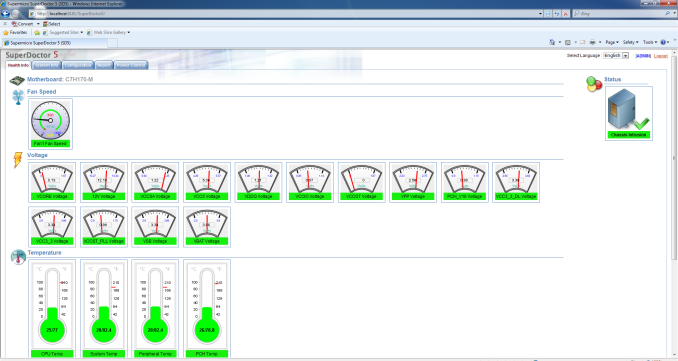

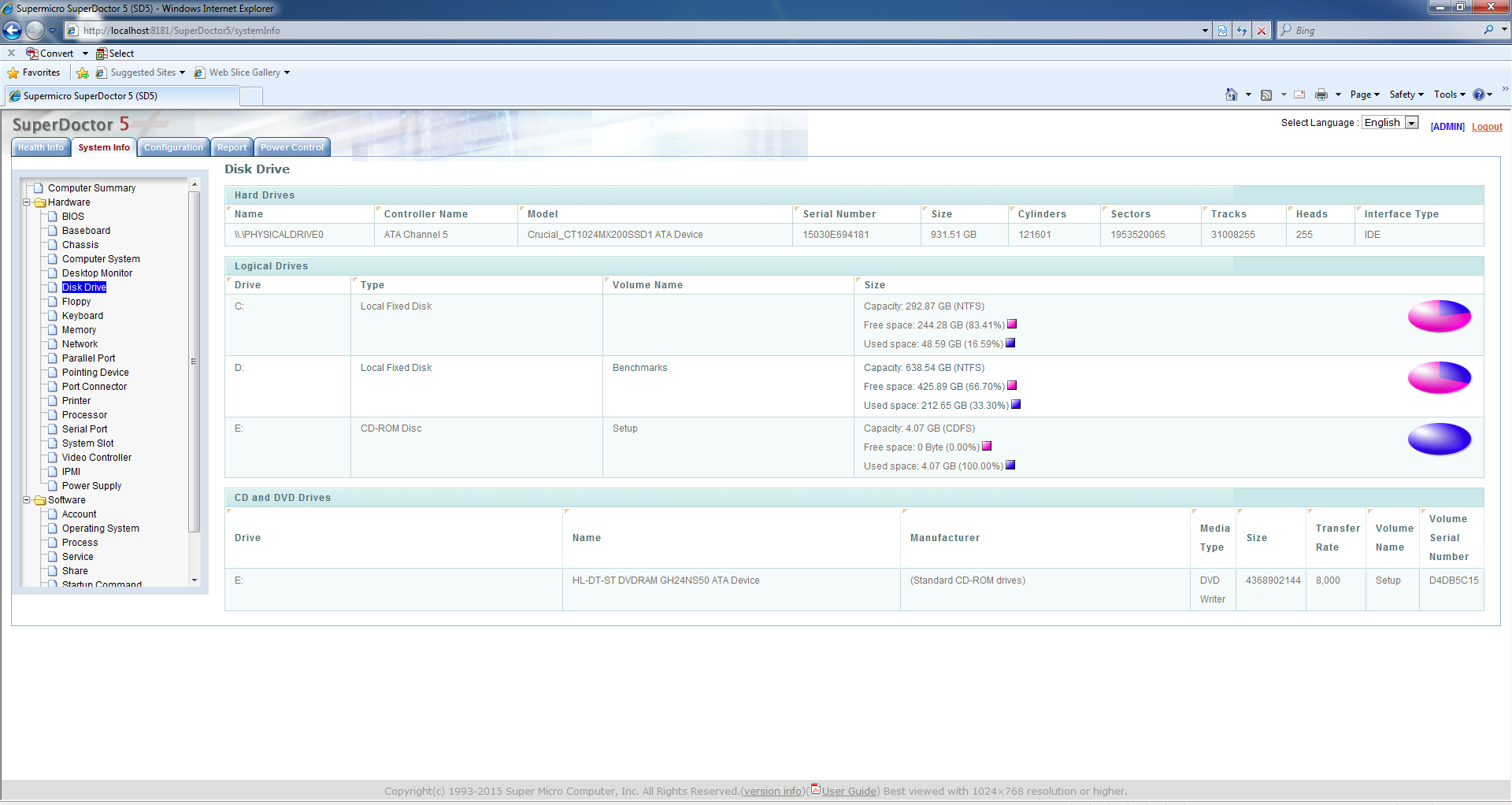
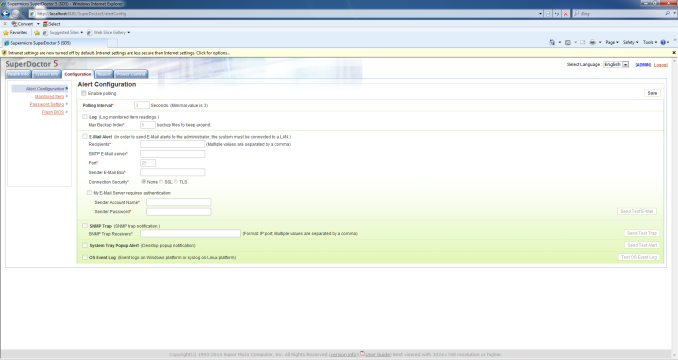
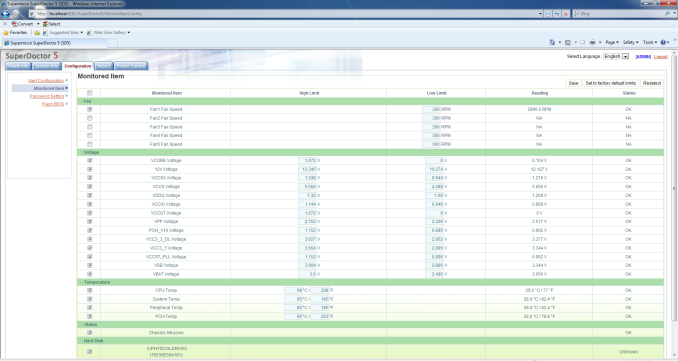
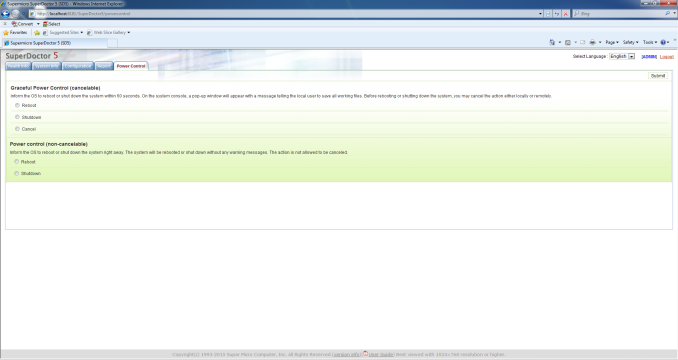
 - First Run_thumb.png)
 - Health_thumb.png)
 - H2_thumb.png)
 - System Info_thumb.png)
 - HDD Info_thumb.png)
 - Config_thumb.png)








62 Comments
View All Comments
RobATiOyP - Sunday, March 20, 2016 - link
Yep.. and that's why desktop CPUs are 2 or 4 core; programs tend not to scale linearly to CPUs thanks to lock contention and Amdahl's law.When a program waits for net or disk i/o or user input, it rests in an OS wait queue, woken up when the event has completed.
rscoot - Thursday, March 17, 2016 - link
The heyday of overclocking for me was getting 50% OCs with a celeron 300A in a 440BX mobo, through mobile AMD XPs that you could push from 1.5GHz to 2.7 and beyond if you had some BH-5 and a DFI Lanparty mobo to Athlon 64s that would go from 1.8GHz to 2.7Ghz with the same RAM.BrokenCrayons - Thursday, March 17, 2016 - link
The 300A was a good time for overclocking. I never had much luck in the chip lottery with AMD CPUs. My T-birds and T-breds must have been duds, but there was a 350MHz K6-2 that I squeezed pretty hard using a peltier cooler I snagged from a computer show. Doing nothing to mitigate condensation wasn't a bright idea though. My favorite overclocked chip was a 100MHz Pentium which was getting long in tooth by the 1998. A few minutes messing with DIP switches on the motherboard got it up to 133MHz with no consideration to cooling or voltage. The heatsink was glued on by the OEM and the chip (which still exists to this day in a cardboard box) was utterly apathetic to the change.bill.rookard - Thursday, March 17, 2016 - link
It is really a shame that you pretty much do have to go back in time to get overclockable parts, but careful shopping will get you quite a lot for a little. My current build which I just put together a few weeks ago was a Xeon X3470 ($70) with an Asus P7F7-E WS motherboard. BCLK overclocking went from 2.9ghz to 4.2ghz.pizzahut22 - Thursday, March 17, 2016 - link
This article is so silly. Why did you overclock a i3 6100TE? You basically took it and made it into a standard i3 6100... Not to mention its an OEM part that nobody will be using for this.This article blows my mind. Just overclock a standard i3 6100 and give us the numbers compared to stock i5 and i7s, and overclocked i5 and i7s. Also give us some graphs about price/performance and talk about that. This article is well below typical Anandtech standards.
OrphanageExplosion - Thursday, March 17, 2016 - link
Eurogamer has all the Core i3 6100 overclocking data you need plus tons of FCAT: http://www.eurogamer.net/articles/digitalfoundry-2...In CPU-limited scenarios, an overclocked i3 with fast memory dukes it out with a Core i5 6500 with slower memory when both are paired with a Titan X (which means you're CPU-bound more of the time). I would imagine that the gap narrows if you're running something like a GTX 970.
The real question I want answered is this: if I apply a BIOS update that locks out Skylake non-K OC, do I get it back by reverting to an older BIOS?
dualsmp - Thursday, March 17, 2016 - link
I wouldn't update if you have a working overclock. I've seen a few posts about people updating their board, then reverting back to the old BIOS and it does NOT overclock anymore. It sets some kind of kill bit and overclocking does not return.OrphanageExplosion - Friday, March 18, 2016 - link
Thanks!silverblue - Friday, March 18, 2016 - link
I'd be somewhat annoyed if I'd written a 15,000 word article only to have it shot down by people who don't see my point of view, but maybe I'm not getting it.Shadowmaster625 - Thursday, March 17, 2016 - link
This has got to be some kind of joke. There is already an i3-6320 which runs at 3.9GHz. What is this review supposed to be telling us? Seems completely pointless. And then they throw in a 4.7GHz G3258 just to further highlight the pointlessness. Where is the 4.7GHz i3?